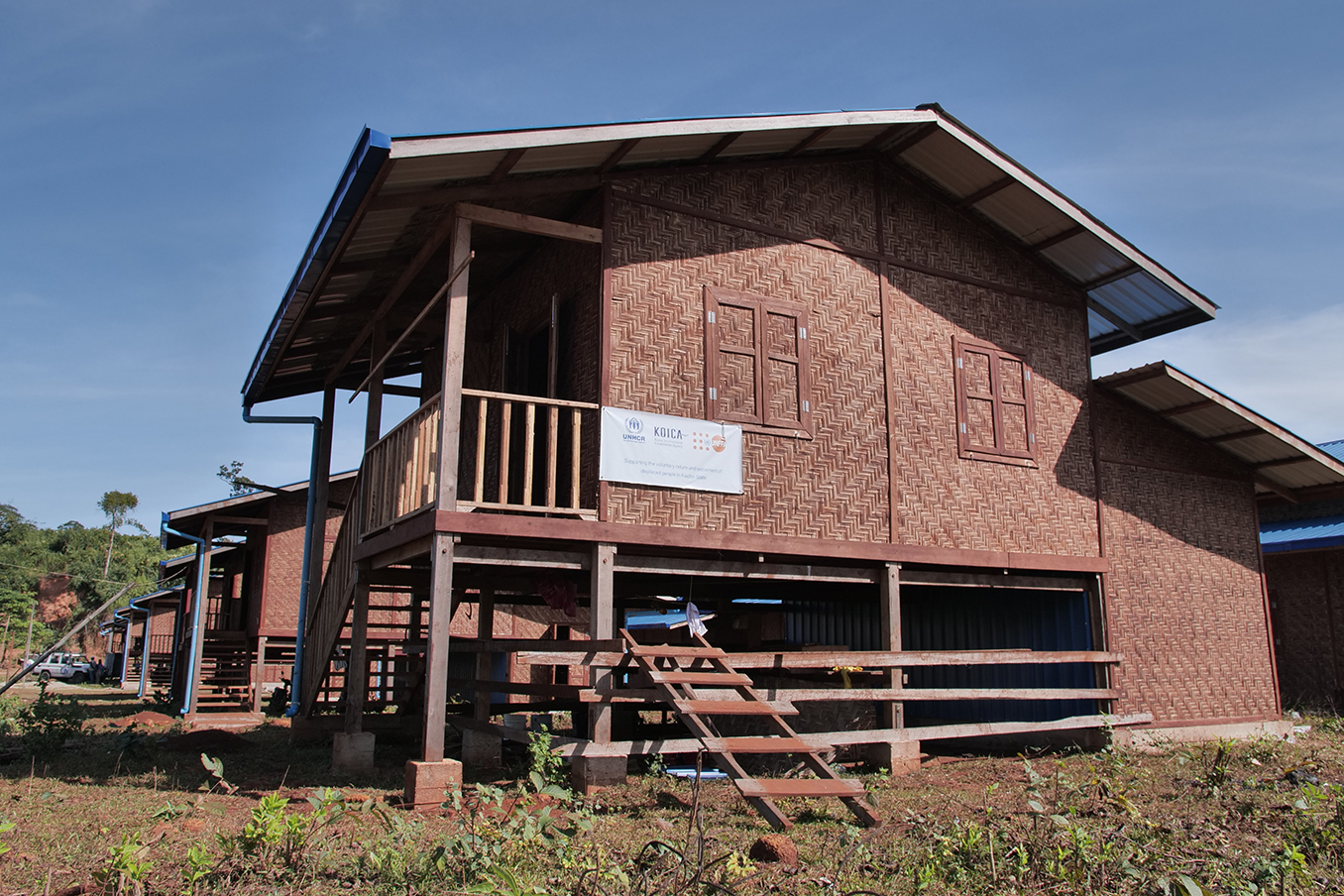Displaced families yearn for home in Myanmar’s forgotten conflict
Displaced families yearn for home in Myanmar’s forgotten conflict

The Mya Ta Saung site for internally displaced people in Rakhine State’s Mrauk-U Township is within walking distance of 500-year-old stone pagodas.
Mrauk-U, Rakhine State, Myanmar — The sound of heavy rain rattling metal roofs reverberates throughout the Mya Ta Saung site for internally displaced people in Rakhine State.
In the distance, 500-year-old stone pagodas punctuate the verdant landscape. Mrauk-U Township, where Mya Ta Saung site is located, is renowned for its rich cultural heritage and for being the capital of a once-prominent Arakan kingdom.
At Mya Ta Saung’s Buddhist monastery, women patiently wait their turn to collect relief items from UNHCR, the UN Refugee Agency. Religious buildings and host communities play a key role in supporting displaced families, often acting as places of refuge in times of conflict.
Carefully balancing large green sacks on their heads, they make their way back to their shelters, navigating through muddy paths and knee-high waters as the monsoon rains continue to fall. The site regularly floods during heavy rain and residents are forced to use improvised bamboo walkways to move around.

Women carefully balance large sacks of UNHCR relief items on their heads as they make their way back to their shelters.
In one shelter, Oo Thein Hle, 57, huddles together with her husband, children and grandchildren inspecting the sack’s contents. Inside are basic household items including blankets, sleeping mats, kitchen sets and mosquito nets.
“Without outside assistance, our lives would be much more difficult,” said Oo Thein Hle. Her family, who were farmers, were forced to forsake their land when mortar shells landed on their village and destroyed their home.

Oo Thein Hle (left), 57, huddles together with family to inspect relief items provided by UNHCR.
Today, Mya Ta Saung offers safety to over 1,100 people from four nearby villages. The majority arrived in 2019 when fighting between the Arakan Army, an ethnic armed organization and the Myanmar Armed Forces rocked the area.
Since the conflict began in 2018, it has displaced over 100,000 largely ethnic Rakhine people across central and northern parts of Rakhine State, of which about 51,000 still remain displaced today. The impact of the conflict is less known since much of the international focus has been on the Rohingya, another ethnic group from Rakhine State. The Rohingya have been affected by violence and face severe restrictions on their fundamental rights, including citizenship, freedom of movement and access to basic services.

An elderly man walks on a makeshift bamboo walkway built over floodwaters at the Mya Ta Saung site for internally displaced people. The site regularly floods during the monsoon season.
Four years since their displacement, Oo Thein Hle’s family, like many others in Mya Ta Saung, struggle to make ends meet due to limited job opportunities. Rakhine is among the poorest and least developed states in Myanmar and the communities are heavily reliant on humanitarian aid provided by several organizations in order to survive.
In addition to basic household items, UNHCR also provides shelter support to displaced communities. Since January 2023, over 44,000 people in nine Rakhine townships affected by the conflict have received assistance from UNHCR.
Sustainable returns unlikely
Many families in Mya Ta Saung yearn to return to their villages, but tensions and insecurity continue, threatening the fragile ceasefire agreed upon in November 2022. “There is less freedom for us here [at the displacement site]. In our village, we could do whatever we liked and go wherever we wanted…but we are scared to return,” said Oo Thein Hle.
Despite being located just four miles away from the displacement site, Oo Thein Hle’s village is still considered unsafe to return to. The presence of landmines in the area means families cannot tend to their crops, maintain livestock or forage for bamboo. The village is also flanked by hills which are still occupied by armed combatants.

Oo Thein Hle (left), her husband (right), children and grandchildren have lived at the Mya Ta Saung site for internally displaced people since 2019. The family remains uncertain when they will be able to return home.
Adding to the pressures faced by displaced communities is the prospect that the site could be closed down by de facto authorities, a possibility that heightens their vulnerability. While Mya Ta Saung has not been slated for closure, families at several displacement sites elsewhere have been forced to return to their villages or relocate elsewhere.
“While the majority of displaced people have expressed their desire to return to their villages, many do not feel safe doing so primarily due to the fear of the reassumption of clashes and the presence of landmines. The sustainability of returns is very much linked to security,” explains Federico Sersale, UNHCR’s Head of Office in Sittwe.
“Displaced families have a right to return to their villages in safety and dignity, but the decision needs to be an informed one and of their own volition. No one should be forced to return or leave their place of displacement. UNHCR will continue to support families with humanitarian aid along with their search for durable solutions,” he adds.
With prolonged insecurity and the threat of armed conflict resuming, Oo Thein Hle is uncertain when she will be able to return home. “We might end up living here [in Mya Ta Saung] forever and die here,” she says through tears. “I feel like there is no future for us.”
For more information on UNHCR’s assistance to communities affected by the Arakan Army – Myanmar Armed Forces conflict, please refer to our latest dashboard: https://data.unhcr.org/en/documents/details/103563
Myanmar language dashboard: https://data.unhcr.org/en/documents/details/103559









